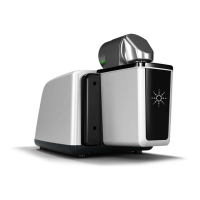Analyzing Samples
48 Agilent Cary 630 FTIR Spectrometer User’s Guide
CAUTION
The top and bottom windows are made from ZnSe. ZnSe can be damaged by
samples with a pH below 4 and above 9. Only measure samples with a pH
between 4 and 9.
CAUTION
ZnSe windows can be easily scratched by hard or abrasive samples. Avoid use of
samples that may scratch the surface of the windows.
Optimum transmission pathlength is one important consideration
when using the TumblIR for a range of liquid sample types. Because
the TumblIR pathlength is pre-aligned and fixed at 100 microns, some
sample types, such as high infrared absorbing materials, may not give
optimum results.
4 Close the TumblIR by rotating the arm clockwise until it clicks
into place.
5 For instructions on collecting a sample spectrum using the
software, refer to the Agilent MicroLab PC Software User’s Guide.
6 After completing the sample measurement, immediately clean the
sample from the accessory using the instructions provided on
Page 46. It is important to make sure both the top and bottom
windows are free of any residue from the previous sample.
For instructions on reviewing results and handling sample data, refer
to the Agilent MicroLab PC Software User’s Guide.
DialPath Sampling Accessory
The DialPath sampling accessory is based on the same technology as
the TumblIR sampling accessory. The DialPath uses the TumblIR’s
unique liquid transmission sampling accessory designed and
manufactured exclusively by Agilent to optimize the analysis of many
liquid, paste and gel samples. Compared to traditional liquid cells for
general analytical laboratories, the DialPath makes it much easier to
prepare, load, analyze and clean the sample, while providing the
flexibility of choosing from three factory-set pathlengths.
The DialPath operates in two modes: sample loading/cleaning and
sample analysis.

